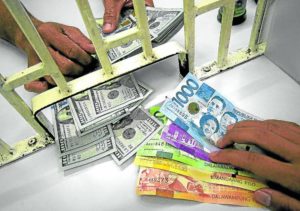
MANILA, Philippines — The Bangko Sentral ng Pilipinas (BSP) is ready to defend the peso as the local currency sinks to 17-month lows amid a rallying US dollar, its governor said.
In a statement on Thursday, BSP Governor Eli Remolona Jr. explained that the recent depreciation of the local unit was more of a case of strengthening dollar than peso weakness, as geopolitical risks, and shifting outlook on rate cuts in the United States trigger a capital flight to safety.
“The story has been one of dollar strength rather than peso weakness. Escalating tensions in the Middle East led to safe-haven flows into the US dollar at the expense of most other currencies,” Remolona said.“Nonetheless, the BSP continues to monitor the market and stands ready to manage any unnecessary movement and excessive volatility,” he added.
READ: Peso sinks to 17-month low vs dollar
The last time the BSP sold some dollars from the country’s reserves to prop up a falling peso was last year, when the currency touched the critical 57-level.
The peso found itself back in that territory. On Friday, the local currency capped another turbulent trading week at 57.71, still the weakest performance since November 2022, albeit stronger than its previous day finish of 57.78.
Forex market intervention
Remolona earlier said the central bank had hardly been intervening in the foreign currency market recently. So far, the peso has been trading above the 55 to 57 assumption of the Marcos administration for this year.
It remains unclear at what level the BSP would act to soothe the volatility and prevent the peso from pushing up import costs and stoking inflation.
READ: BSP to temper forex mart intervention
Apart from foreign exchange interventions, the BSP’s anti-inflation interest rate hikes can also help support the peso by making domestic yields more attractive to investment inflows.
What Remolona made clear was that the recent depreciation of the peso would unlikely trigger any policy actions from the BSP, which has kept its key rate unchanged at 6.5 percent, the tightest in nearly 17 years.
The central bank chief, however, admitted that the room to ease monetary policy has narrowed, as he floated the possibility of a later rate cut in the first quarter of 2025 if inflation behaves badly.
In its latest “The Market Call” report, analysts at First Metro Investment Corp. and the University of Asia and the Pacific said the peso would “generally experience depreciation pressure for the rest of the year.”
“The peso-dollar rate should have a depreciation bias as large importations for the infrastructure projects and rice imports keep trade deficits elevated,” they said.

